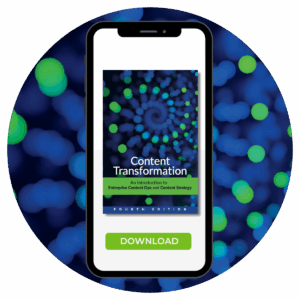Building your futureproof taxonomy for learning content (podcast, part 2)
In our last episode, you learned how a taxonomy helps you simplify search, create consistency, and deliver personalized learning experiences at scale. In part two of this two-part series, Gretyl Kinsey and Allison Beatty discuss how to start developing your futureproof taxonomy from assessing your content needs to lessons learned from past projects.
Gretyl Kinsey: The ultimate end goal of a taxonomy is to make information easier to find, particularly for your user base because that’s who you’re creating this content for. With learning material, the learner is who you’re creating your courses for. Make sure to keep that end goal in mind when you’re building your taxonomy.
Taxonomy: Simplify search, create consistency, and more (podcast, part 1)
Can your learners find critical content when they need it? How do you deliver personalized learning experiences at scale? A learning content taxonomy might be your solution! In part one of this two-part series, Gretyl Kinsey and Allison Beatty share what a taxonomy is, the nuances of taxonomies for learning content, and how a taxonomy supports improved learner experiences in self-paced e-learning environments, instructor-led training, and more.
Allison Beatty: I know we’ve made taxonomies through all sorts of different frames, whether it’s structuring learning content, or we’ve made product taxonomies. It’s really a very flexible and useful thing to be able to implement in your organization.
Gretyl Kinsey: And it not only helps with that user experience for things like learning objectives, but it can also help your learners find the right courses to take. If you have some information in your taxonomy that’s designed to narrow it down to a learner saying, “I need to learn about this specific subject.” And that could have several layers of hierarchy to it. It could also help your learners understand what to go back and review based on the learning objectives. It can help them make some decisions around how they need to take a course.
Transform L&D experiences at scale with structured learning content
Ready to deliver consistent and personalized learning content at scale for your learners? In this episode of the Content Operations podcast, Alan Pringle and Bill Swallow share how structured content can transform your L&D content processes. They also address challenges and opportunities for creating structured learning content.
There are other people in the content creation world who have had problems with content duplication, having to copy from one platform or tool to another. But I will tell you, from what I have seen, the people in the learning development space have it the worst in that regard—the worst.
— Alan Pringle
Our top four topics for 2024
Did you miss a podcast, blog post, or webinar? We get it–there’s too much content and not enough time, but we’ve got you covered. Here’s a collection of our biggest topics from this year.
tcworld 2025
November 11th—13th
Stuttgart, Germany
Come see us at tcworld 2025, the largest technical content conference in the world! Hear Scriptorium CEO Sarah O’Keefe speak in the following session.
Accelerating global content delivery with structured learning content
This case study presentation describes an implementation of structured learning content for a major organization that supports technology professionals with training and certification programs
The organization client manages a growing portfolio of digital content, certification materials, and training resources. They needed robust, scalable content operations to keep pace with evolving learning needs and market demands. They evaluated several traditional learning content systems, but none of them met their stringent requirements for authoring, flexibility, automation, and extensibility. Ultimately, the organization decided to build learning content ops on a DITA-based CCMS.
Today, the source content is unified in a centralized repository where all content is stored and managed, eliminating the recurring production headaches of duplication, versioning, and copy and paste. Their instructional designers no longer spend time on formatting and file management—instead, they focus on crafting better learning experiences.
The presentation describes the process of moving from traditional learning tools to a component-based approach.
Want to see this session live? Register for tcworld on the conference site.
Make sure we meet!
Contact us to schedule a meeting during the event.
LavaCon 2025
October 5th-8th
Atlanta, Georgia, USA
Join our team in Atlanta for the 2025 LavaCon Content Strategy Conference! Here’s where you can see our team in action during the event.
The impossible dream: Unified authoring for customer content
Is it really possible to configure enterprise content—technical, support, learning & training, marketing, and more—to create a seamless experience for your end users? In this session, Sarah O’Keefe discusses the reality of enterprise content operations: do they truly exist in the current content landscape? What obstacles hold the industry back? How can organizations move forward?
In this session, attendees will learn:
- The challenging status quo in enterprise content ops
- The reasons that we don’t have any good solutions
- A vision of the way forward
Smart content for smart learning: Transforming DITA into LMS courses
Scriptorium launched LearningDITA 10 years ago. When the site struggled to support an ever-increasing number of students, we faced a dilemma. How could we build a new site with a better learning experience while using the same DITA source files as the foundation? In this session, Alan Pringle unpacks the story of LearningDITA, sharing practical insights that apply to anyone who’s looking for a structured approach to learning content.
Learn how we transformed DITA content into LMS e-learning courses by:
- Creating content and assessments using the DITA Learning and Training specialization
- Developing an automated SCORM publishing pipeline
- Customizing how the Moodle LMS integrates SCORM packages into the learning experience
Swag, chatting, and chocolate at the Scriptorium booth
Don’t forget to stop by our booth (#31 in the Salon Ballroom) to chat with our team, grab a free copy of our book, Content Transformation, chocolate, and more!
Save $200 on your LavaCon registration using the referral code Scriptorium25.
Want to make sure we meet?
Contact us to schedule a meeting during the event.
ConVEx 2025
Join the Scriptorium team in sunny San Jose for ConVEx 2025! See our team speak in these sessions:
So much waste, so little strategy: The reality of enterprise customer content
In her keynote session, Sarah O’Keefe will share the current state of software for enterprise customer content, the challenges of integration across incompatible systems, and share her vision of the unified content future.
Fighting words: DITA and the battle for better content
In his game-themed session, Jake Campbell will guide you through how DITA makes your content more flexible, how to use out-of-the-box DITA structures to streamline production and customize output, map content to DITA, and build robust, relevant metadata.
And last but not least, don’t forget to stop by our booth for Scriptorium swag, free copies of the latest edition of our book, amazing chocolate, and more!
From stakeholders to stake-holders: Getting business buy-in for content operations
LavaCon 2024 delivered actionable insights, emphasizing that your business case for content operations requires strong alignment with business goals. Successful content modernization hinges on executive support, effective change management, and a wary eye on AI.
Do enterprise content operations exist?
Is it really possible to configure enterprise content—technical, support, learning & training, marketing, and more—to create a seamless experience for your end users? In episode 177 of the Content Strategy Experts podcast, Sarah O’Keefe and Bill Swallow discuss the reality of enterprise content operations: do they truly exist in the current content landscape? What obstacles hold the industry back? How can organizations move forward?
Sarah: You’ve got to get your terminology and your taxonomy in alignment. Most of the industry I am confident in saying have gone with option D, which is give up. “We have silos. Our silos are great. We’re going to be in our silos, and I don’t like those people over in learning content anyway. I don’t like those people in techcomm anyway. They’re weird. They’re focused on the wrong things,” says everybody, and so they’re just not doing it. I think that does a great disservice to the end users, but that’s the reality of where most people are right now.
Bill: Right, because the end user is left holding the bag trying to find information using terminology from one set of content and not finding it in another and just having a completely different experience.






